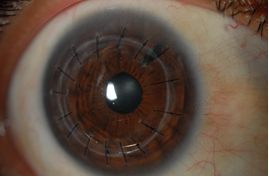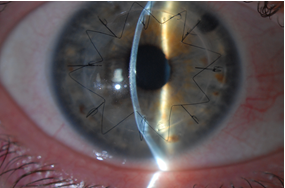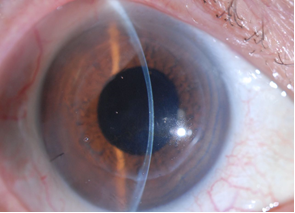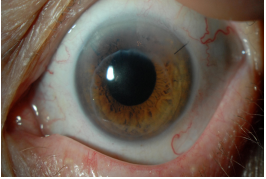Cornea
The cornea is one of the lenses that are part of the eye. As a lens, it requires an adequate shape and transparency. Where these two variables are altered, vision is compromised. When eyeglasses do not help improve it, surgical techniques need to be performed by an experienced surgeon. To such end, a patient comprehensive examination is essential, together with supplementary tests which are necessary for a proper indication of treatments.
Indicated where there is corneal opacity resulting from trauma, infections or diseases that alter its transparency. Also indicated in ectasias, such as largely advanced keratoconus where other less invasive methods have proven unsuccessful.
It consists in transplanting the full thickness of the cornea. A donated cornea is used, which has been chosen for each particular case.
The procedure is carried out in the operating room with local anesthesia. The cornea is stitched up and the stitches begin to be removed 3 to 4 months after the surgery. Recovery is slow and thorough checks are required to assess the evolution and signs of rejection.


The cornea is a tissue made up of several layers distributed regularly. This is the base for performing lamellar grafts, where the affected layer is removed and replaced by a donor’s tissue, preserving the healthy part of the patient’s cornea.
Endothelial transplants (DSAEK/DMEK) are indicated where there is a failure of the function of the cells in charge of keeping the cornea transparent (endothelial cells). DSAEK and DMEK differ in that the former includes more layers (endothelium, Descemet and part of the stroma). DMEK only includes the endothelium and Descemet, i.e., less layers are transplanted. It is mostly indicated in endothelial cell dystrophy, such as in Fuchs’ dystrophy.
There is a procedure for deep lamellar transplant of the cornea using “Big Bubble” technique (DALK). It is indicated in pathologies where the anterior portion of the cornea is altered but the endothelium is normal, such as in keratoconus and some kinds of dystrophies. In this case, parts of the cornea’s layers are separated using an air bubble and the donor’s corneal button. Unlike full corneal grafting, lamellar grafting has several important benefits such as the reduction in visual recovery time, posterior corneal astigmatism and the risk of corneal rejection.


Keratoconus is a condition where the shape of the cornea is altered and takes on the appearance of a cone. This causes a deformation of the cornea with subsequent visual alterations.
The placement of intracorneal ring segments is a procedure conducted in the operating room with local anesthesia. The surgery is aimed at modifying the curvature of the cornea, normalizing and flattening it through the tension generated by the rings. This diminishes the curvature resulting from corneal ectasia.
During the procedure, corneal tunnels are made where the rings are introduced and are placed as per the patient’s needs. After the surgery, patient must undergo periodical checks.

This method consists in making new molecular links with a view to strengthening the corneal collagen debilitated in pathologies such as keratoconus. The treatment should be made in the surgical environment with strict antiseptic care. The patient is provided with topical anesthesia 10 minutes before de-epithelization. Installation of 0.1% riboflavin is performed every 3 minutes for 30 minutes.
Then, ultraviolet light is irradiated for 10 minutes. After washing up, a contact lens is placed. Postoperative treatment consists of antibiotic and anti-inflammatory eye drops.
Crosslinking is indicated in patients having keratoconus or progressive corneal ectasias with a cornea thickness greater than 400 microns.
Expected results:
- Deceleration of corneal ectasia progression.
- Flattening of cone and reduction of keratometry values.
- Enhancement of corrected visual sharpness